guide|pace

GuidePace is a mobile app that I developed to help mountain guides and other backcountry users to be more efficient and accurate at time-planning. As of May 2018, it has more than 1200 users.
All profits are donated to the local avalanche forecasting centers.
Cheers,
Chris
'Great app and one that I use for work (mtn guiding),
as well as days off and ski-touring/climbing with friends.'
- Rob Coppolillo, AMGA/IFMGA Mountain Guide, Vetta Mountain Guides -
'GuidePace is one of my go to apps while guiding.'
- Dale Remsberg, AMGA/IFMGA Mountain Guide, AMGA Technical Director -
'Sleek, simple and effective! Great app!'
- some random guy on iTunes -
The App
Time planning is an essential skill in the mountains, whether you're alpine climbing, ski mountaineering, backpacking, or doing something dangerous, like hunting. When heading into familiar territory, it's easy; but when you're heading somewhere new, GuidePace will help you base your time plan in reality.
GuidePace consists of three calculators for estimating travel time in different types of terrain. They are outlined in the sections below. You enter a rate, distance, and elevation change, and it estimates your travel time. The rate you specify is important and it will depend on a variety of factors, including the characteristics of the terrain, party fitness, and method of travel. To learn more about rates, check out the 'about' section for each page. As you gain experience using the three systems, you'll begin to learn what to expect of yourself and your time plans will become more accurate.
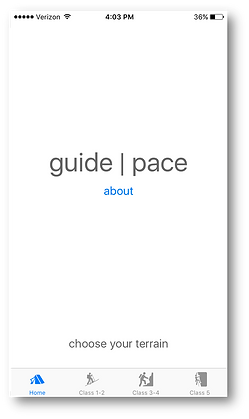
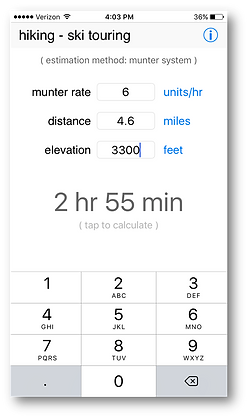
munter system - class 1, 2 terrain - hiking, skiing

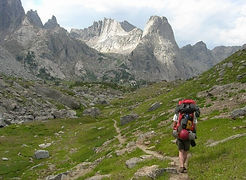
Swiss guide Werner Munter developed the 'Munter Method of Time Calculation' to estimate time for mountain travel in low angle terrain. It is particularly useful for developing tour plans and estimating approach times for alpine climbing, mountaineering, and backcountry skiing objectives. The equation is as follows:
time = (distance + elevation/100) / rate
with time in hours, distance in kilometers, and elevation in meters. Elevation change is entered as an absolute value. i.e. it is positive whether you are going up or down. When traveling downhill a higher rate should be used, but greater elevation change will still result in greater travel time, as is the case in the field. Some typical, moderate rates:
uphill travel on foot or skis - 4
flat or downhill on foot - 6
downhill on skis - 10
bushwhacking - 2
chauvin system - class 3, 4 terrain - scrambling, snow climbing
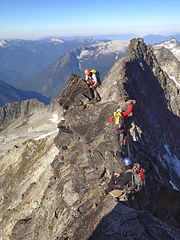
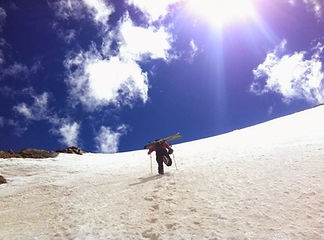
American Mountain Guide Marc Chavin proposed this system for estimated travel time in 3rd and 4th class terrain. It is also useful in other kinds of terrain with indistinct pitches, such as extended snow climbing.
In this method, distance and elevation gain are converted into an equivalent number of 60-meter pitches. Sixty meters is the a standard length for a climbing rope. Most climbers are familiar with this distance, so they tend to find it easier to estimate the amount of time required for a single pitch than for a climb as a whole.
The equation is as follows:
time = (distance x 1000 + elevation) x rate / 60
with time in hours, distance in kilometers, elevation in meters, and rate in minutes per 60m-pitch. Typical rates in this type of terrain are 10-30 min/60m pitch.
technical system - class 5 terrain - rock, ice & mixed climbing
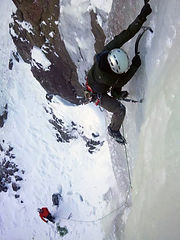
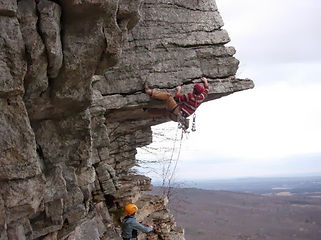
Roped climbing in technical terrain is typically broken up into pitches, which are up to one rope-length long. A typical pitch may take anywhere from 30 minutes to an hour or more depending on the difficulty of the terrain and skill of the party. The equation used by this calculator is simply:
time = pitches x rate / 60
with time in hours and rate in minutes per pitch. Technical decent times can also be estimated by substituting number of pitches for number of rappels.
tour planning - putting it all together
Many times you'll encounter a variety of terrain on a single trip; this is where it is useful to make a tour plan. Break the trip up into legs, and then use GuidePace to estimate the time required for each leg.

[ Privacy policy - GuidePace is a straightforward offline calculator. It doesn't collect or use your data in any way. ]

